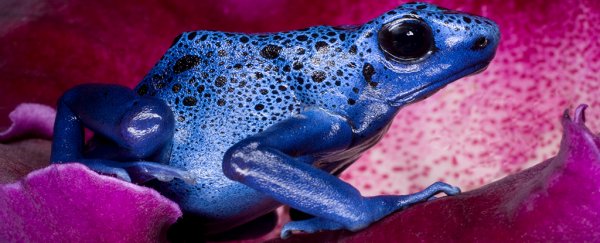Slathering yourself in deadly poison is a great way to discourage predators from trifling with you and your cousins. There is, however, one massive flaw in this genius plan – it involves slathering yourself in deadly poison.
Since toxic compounds typically wreak havoc by locking up an enzyme or receptor, a clever way to avoid a taste of your own medicine is to simply evolve a new set of locks to your deadly keys.
But that doesn't seem to be the method evolution has chosen for birds and amphibians that produce a substance called batrachotoxin.
Researchers from the University of California, San Francisco, Stanford University, and the California Academy of Sciences propose these animals instead might protect themselves from the toxin's effects by relying on a protein to soak it up before it causes problems.
The discovery not only tells us a thing or two about the evolution of toxic defense strategies but could be useful in inspiring new antidotes to poisonous substances.
Batrachotoxin is a neurotoxin derived from an alkaloid produced by certain beetles. The alkaloid doesn't pose a problem for a handful of bird species in Papua New Guinea (such as the Pitohui) and various poison dart frogs endemic to tropical forests in Columbia. In fact, consuming the beetles simply gives them a toxic boost.
It's thought the golden poison frog Phyllobates terribilis squeezes out roughly a milligram of batrachotoxin through glands in its skin. It might not sound like much, but it'd be plenty to put a good dozen or so humans in an early grave.
And it's not just humans who'd need to worry. Since the toxin works by binding to the sodium channels that control nervous impulses, it kills just about anything with nerves and a heartbeat.
The obvious question is why doesn't it block the sodium channels in either the poison dart frogs or the Papuan birds?
It's easy to assume that their own sodium-shunting proteins are conveniently the wrong shape. In fact, previous studies have even identified candidate mutations that just might be behind that immunity.
"However, there haven't been any functional studies of poison frog or Pitohui sodium channels, so whether batrachotoxin-bearing animals rely on changes within their sodium channels or alternative resistance mechanisms remains unclear," says Daniel L. Minor, Jr, a biochemist from the University of California, San Francisco.
The team set about filling this gap in knowledge by cloning and studying voltage-gated sodium channels found in the bird Pitohui uropygialis meridionalis, and two poison dart frog species – one that carries the batrachotoxin and another with similar toxins.
They quickly found that the candidate variant in sodium channels actually made for poor protection. Not only does it fall short on providing a high degree of resistance, it didn't even work all that well in their nerves as a sodium channel.
"Taken together, our observations challenge the idea that sodium channel mutation is the batrachotoxin autoresistance strategy for poisonous birds and poison frogs such as P. terribilis," says Minor.
Going back to the drawing board, the researchers conclude that something has to be intercepting the toxic molecules before targeting the sodium gates. Even on injecting the frogs with the toxin, they seemed unaffected.
Though the study doesn't go as far as identifying any 'toxic sponges', such a discovery wouldn't be unprecedented. Minor previously found American bullfrogs (Rana catesbeiana) produced proteins that acted as a shield against deadly neurotoxins produced by cyanobacteria.
Called saxiphilin, it binds to saxitoxin and renders it ineffective, possibly helping the frog survive in the midst of algal blooms.
Whether or not a similar kind of protection is definitely at work inside poison dart frogs and Pitohui is yet to be confirmed. But it's a sound bet Minor and his colleagues will be sure to look into.
"These sequestration strategies might not only offer a general means of toxin protection but could also act in pathways involved in safely transporting and concentrating toxins in key defensive organs such as the skin," says Minor.
"Understanding these pathways may lead to the discovery of antidotes against various toxic agents."
This research was published in the Journal of General Physiology.
